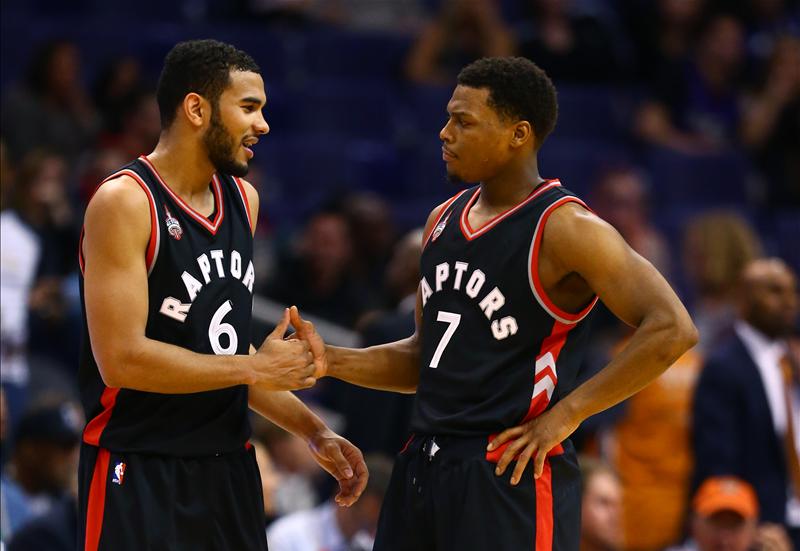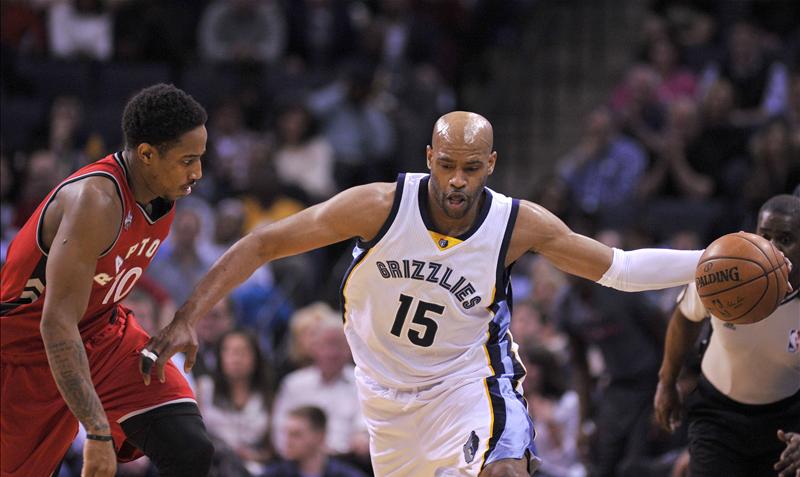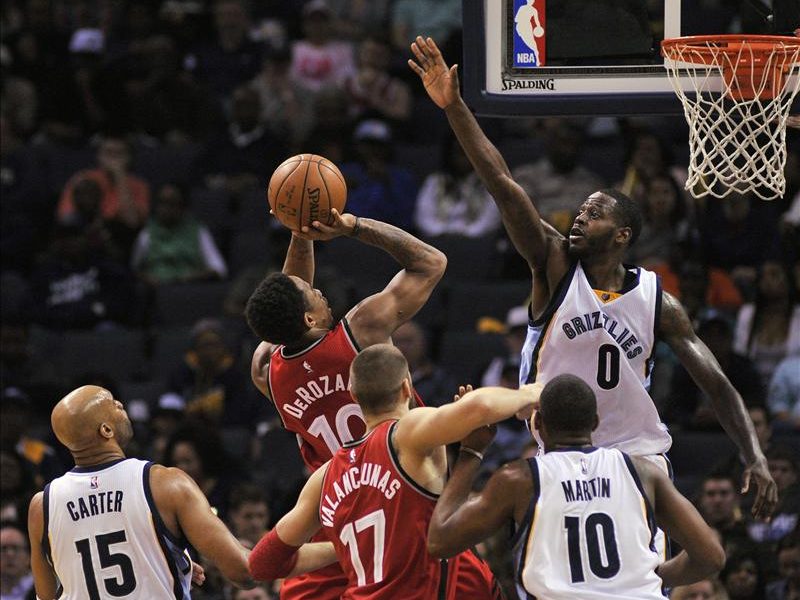The pattern has become beyond familiar for Toronto Raptors fans. The starting lineup plays to a draw, or worse, a DeMar DeRozan-led bench unit settles things down late in the quarter as Kyle Lowry rests, and then Lowry returns for DeRozan to start the second quarter and the team takes off. Then it’s repeated in the second half. Struggling to start halves isn’t the way a team would like to come out of the gate, but the Raptors’ mixed reserve units have been so good for over a year now that head coach Dwane Casey has eschewed an optimal starting lineup, in part because he’s aware there are gains to be made elsewhere as a result. The Raptors may not have the league’s most effective starting lineup, but they have one of the deepest second units in the league. As Casey staggered minutes for Lowry and DeRozan more aggressively, units with only one of them thrived, feasting on opposing groups who didn’t boast a DeRozan or Lowry.
A season ago, the “Lowry and bench” unit featuring Cory Joseph, Terrence Ross, Patrick Patterson, and Bismack Biyombo was heralded for their two-way play, and its success was striking – that group outscored opponents by 16.4 points per-100 possessions (PPC) over 297 minutes. That’s a relatively substantial sample (it was the team’s second-most used lineup, though small-sample caveats will apply to any lineup data), and the fact that a few of those minutes came when Biyombo was the starter doesn’t really change the story here.
They were very good both ways, with Patterson, Biyombo, and Joseph ranking among the team’s best individual defenders and the somewhat inconsistent Ross providing necessary shooting and spacing. Lowry benefited from being able to spot up a little bit alongside Joseph and pick his spots more carefully on defense, and though his workload remained heavy, these minutes against opposing benches were a little easier on him (Lowry and Joseph together were dominant in pretty much any lineup iteration).
“I’m more of an aggressive scorer and looking for shots more, and more of a guy who’s spacing and being a decoy and letting those guys get theirs,” Lowry explained Tuesday. “I’ll call plays for other guys when I’m out there. For me it’s kind of a chance to rest but still be aggressive.”
As terrific as that group was, it wasn’t clear they’d be able to perform as well in 2016-17. Not only did Biyombo leave for the Orlando Magic, opening up a massive hole in the backup center position, but it looked as if Patterson may be leaned on to start. Patterson wound up coming off the bench in favor of rookie Pascal Siakam starting, and after some shuffling – Jared Sullinger got injured, Lucas Nogueira sprained his ankle, and then Jonas Valanciunas missed two games allowing Nogueira to get back in the mix with Jakob Poeltl – Nogueira emerged as the man in Biyombo’s slot.
Because the season is so young and the Raptors have juggled players in and out of roles, we’re dealing with extremely small samples with any lineup data, but on paper the Lowry-and-bench group with Nogueira should have been effective. Nogueira’s not a Biyombo-level defender or rim protector, but his length is an issue for opposing shooters, he has some defensive range, and he’s a comparable screen-setter and an even bigger lob threat. Lineup data is best used not to make sweeping determinations, but to back up logic or qualitative observation, and in that sense, it’s not surprising that the group is thriving once again.
That unit has played 75 minutes over 10 games, once again the second-most used Raptors lineup, and they’ve rolled opponents by 27.6 PPC. Unlike the previous edition, they’re getting it done by pushing the offense even higher and improving the defense marginally, whereas the 2015-16 group was dominating almost exclusively on the defensive end. How to make up for the loss of Biyombo was a popular discussion point early in the year, and the solution proposed was often to make up for the loss with small gains elsewhere – that’s what this unit is doing offensively, with a little more room to breathe thanks to Nogueira’s additional range and ability to make plays on the short-roll. He’s not Biyombo, but points are points, saved or scored, and that unit has picked up where it left off. (Yes, it’s frustrating for the team to be down at 20th in schedule-adjusted defensive rating – everyone wants balance – but they’re third in adjusted net rating, so it’s hard to complain too much with the results to date.)
In Nogueira’s mind, earning the trust of his teammates has been a big factor in the early chemistry that group has developed. Even if it’s come from something as simple as catching on the dive.
“I think it’s about trust,” Nogueira says. “Because, it’s hard, if you play pick and roll, when you roll and the point guard pass you the ball, if you don’t catch, it’s a turnover for him. Any point guard doesn’t wanna have a lot of turnovers in a game. So because I catch those alley-oops, those pocket pass, builds the trust in me and Kyle. No point guard’s gonna pass to you if you don’t catch the ball. So I think this is the reason we started building this connection.
“I’m so happy we work well, and I hope it works for many years.”
It seems simple enough. The onus will remain on Nogueira to fight off Poeltl for his role, because for as much good as Nogueira’s shown, he’s had occasional off nights or distracted stretches of play. The Lowry-and-bench group with Poeltl in Nogueira’s place was woefully ineffective in 38 minutes together, but Poeltl as an individual has shown some intriguing signs, and the position could be fluid if the inconsistencies that have plagued Nogueira in his first two seasons creep back in.
Playing minutes with Lowry, long a believer in and supporter of Nogueira, helps beyond just tactical chemistry. Against Milwaukee on Friday, Nogueira was struggling through a rough day in general and another night with a loose whistle from officials, only to shake off the cobwebs and produce a pair of highlight-reel blocks in a row.
Lowry’s reaction was priceless, and while it may have looked like Lowry in his grill on first blush, it was exactly the kind of push Nogueira occasionally needs.
“He came to motivate me,” Nogueira said. “Because I was kinda down that game…I was very frustrated. So when I blocked those two in a row, he came and grabbed me and said ‘You’re doing well.’ Because he saw how down my head was. So he came to yell at me, ‘You’re doing great.’ This is the reason, people ask me, ‘Who is the leader?’ I say ‘Kyle.’ Because he’s a great leader, and when he saw me down, he came and grabbed me and said ‘Let’s go, let’s go.’”
That’s not to say the success of Nogueira in that Lowry-led second unit is a given as permanent. But it’s encouraging, at least, and a way the Raptors can help make up for a starting lineup that’s only playing opponents to a slight positive margin so far (and that’s trending upward, too, which is nice). Despite the loss of the team’s best defender off the bench, depth still appears to be a strength for the Raptors.
—
(The DeRozan-led bench unit, meanwhile, outscored opponents by 13.7 PPC over 218 minutes last year. While they were nearly as dominant, those looks didn’t get quite the reputation that the Lowry-led unit did, in part because it was essentially unplayable in the postseason. They’ve also started this year out poorly – 12.7 PPC in 40 minutes – but there’s reason to believe it can eventually succeed, as well.)



